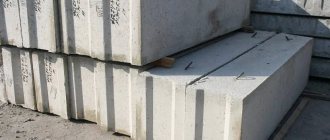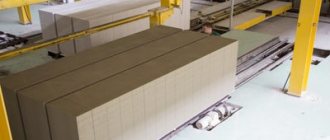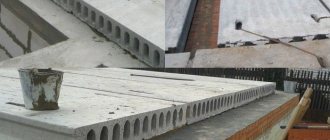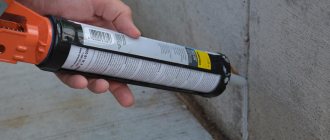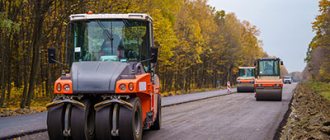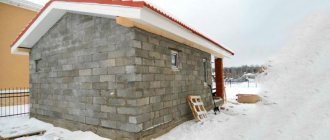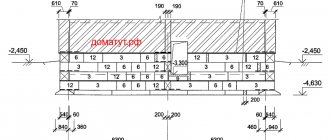An alternative to a monolithic foundation is a prefabricated one. In private housing construction today it is used quite often, because it is fast and convenient. And although the price of foundation blocks is high, many developers prefer to contrast the price with the speed of construction of the foundation of the house. Let's understand what FBS blocks are: dimensions, technical characteristics and installation nuances.
FBS blocks for foundation Source www.stroi-baza.ru
What is FSB
This is an abbreviation for building material, which stands for solid foundation block. Sometimes instead of “solid” you see “construction” or “wall”, which is completely wrong.
So, having dealt with the decoding of the FBS, we move on to the building material itself. These are blocks made of heavy concrete. There are lighter products on the market made from expanded clay concrete or dense silicate concrete, but they are used only for small, lightweight buildings.
The production process is based on pouring concrete mortar into molds, where a reinforcing frame made of steel reinforcement is pre-installed. Therefore, FBS blocks are classified as reinforced concrete products. Hence their high strength.
Forms for pouring FBS blocks Source permmetallprof.ru
Storage and transportation
The FBS 24 6 6 t concrete block must be stored vertically, and each block must be laid on a special substrate with a thickness of at least 3 mm. Such measures will prevent deformation and protect the material from moisture. Materials can be stored in stacks not exceeding 2.5 meters in height. The gap between the stacks should be enough for special equipment to access.
FBS 2400x600x600 should be transported only in a well-secured form. Any displacements during transportation must be excluded. And loading and unloading should be carried out exclusively using special equipment.
Specifications
Typically, heavy concrete with a density of 1800-2400 kg/m³ is used for the manufacture of FBS. At the same time, depending on the category of the concrete mixture, the grade of concrete is determined. Eg:
- if the category is more than B7.5, then concrete grade M100 is used;
- B12.5 and above – M150;
- for heavy concrete: B3.5 – M50, B15 – M200.
The moisture resistance of blocks according to GOST should not be less than W2. FSB should easily withstand 50 cycles of freezing and defrosting. There is no need to talk about thermal conductivity qualities; it’s still pure concrete. And although manufacturers offer foundation blocks made of expanded clay concrete, the thermal insulation qualities still leave much to be desired.
Marking of the foundation block Source st29.stpulscen.ru
Let's look at block labeling. For example, FBS-24-4-6 t. What the numbers mean are the sizes of the foundation blocks. That is, length 2380 mm, width – 400, height – 580. The letter “t” means that the product is made of heavy concrete. If silicate concrete was used, then the letter “c” would be placed at the end of the marking. If it was expanded clay concrete, then the letter “p”, that is, with a porous base.
Please note that the minimum weight of the foundation block is 260 kg. Even for this you will have to use heavy equipment. They are usually used to build foundations for lightweight structures. More often, standard products weighing 1960 kg are purchased for the construction of houses.
It is very important to consider the ratio of the mass of the block and its dimensions. For example, if the weight is below standard, then there is a high probability that there are voids inside the product that reduce the strength of the material. Or, during the process of pouring the concrete solution into the molds, the latter was poorly compacted.
Please note that manufacturers also offer other types of foundation blocks. The only difference in their markings is the lettering. Eg:
- FBP are blocks that have hollow areas at the bottom.
- FBV are products that contain channels for laying communication networks.
By the way, the weight of FBS differs from the other two modifications.
Hollow foundation blocks - FBP Source stk-uspeh.ru
See also: Catalog of companies that specialize in foundation construction.
Sizes and prices
Depending on the size of FBS blocks, manufacturer and region, the price may vary.
For example, an FBS block with dimensions 880 x 300 x 580 FSK "Tores" in the city of Ufa costs 655 rubles per piece, and in Moscow it offers the same product for 843 rubles.
per piece Table 3 - Dimensions and average price per piece in Moscow
| FBS 4-3-3 | 358 rub. |
| FBS 4-3-6 | 612 rub. |
| FBS 6-3-6 | 863 rub. |
| FBS 6-4-3 | 848 rub. |
| FBS 9-3-6 | 640 rub. |
| FBS 9-4-3 | 831 rub. |
| FBS 12-6-3 | 836 rub. |
| FBS 12-6-6 | RUB 1,742 |
| FBS 24-5-3 | RUB 2,253 |
| FBS 24-5-5 | RUB 2,612 |
Figure 6 - Appearance of a reinforced concrete product for a foundation 200 x 200 x 400
Foundation block 200 x 200 x 400, the price of which is 55 rubles. per piece, is not a type of FBS blocks. It is made of concrete grade M100 and has a frost resistance rating of F50. But due to its small size, experienced builders do not recommend using it at the base of the foundation.
The advantage of foundation blocks 200 x 200 x 400, the price of which is pleasing to the eye, is the ability to lay the foundation in places inaccessible to vehicle access. The weight of one block is in the range of 30 - 35 kg, and for a one-story building (cottage, bathhouse, barn), concrete blocks for a foundation of this size are just right.
Dimensional parameters of foundation blocks
GOST is a law for manufacturers. It accurately indicates the parameters of the technological process, the characteristics of the product being manufactured, as well as the dimensions of the latter. FBS blocks did not escape this fate. Therefore, the state standard precisely establishes the dimensions:
- length – 1180 and 2380 mm;
- width – 300, 400, 500, 600 mm;
- height – 280, 580 mm.
There are so-called additional elements, whose width and height are the same as those of standard blocks. But their length is shorter and is only 880 mm. Some manufacturers produce so-called small-sized products with the same height and width. But their length is 400 and 600 mm.
There are foundation blocks on the market manufactured according to specifications. This is when the equipment and technology do not meet the requirements of GOST, then it is allowed to produce building materials, but so that it meets the state specifications.
The photo below shows a table of sizes of FBS blocks.
Dimensions of FBS blocks Source www.profibeton.com.ua
Why do you need to know the weight of the slabs?
The disadvantage of blocks is that their installation process is quite complicated
FBS is used for installing the foundation and erecting walls. Their main advantage is that these structures arrive at the construction site in finished form, so there is no need to waste time on concrete achieving the required strength. This speeds up the work significantly.
In the manufacture of these building elements, special technologies are used: drying or steaming of products in a factory, this provides the blocks with a standard degree of hardness, frost resistance and compressive strength. To protect the slabs from the aggressive action of atmospheric and groundwater, they are covered with a bitumen-based waterproofing layer.
The weight of the slabs depends on the size of the products and the brand of concrete that was used in their manufacture, plus the amount of reinforcement. It affects the quality and strength of the base. You can find out by using the assortment.
Of course, it is advisable to entrust the calculation of the foundation to professionals, but you can also use an online calculator for these purposes. To independently calculate the number of foundation blocks, you need to divide the volume of the foundation by the volume of one block. After this, select the dimensions of the FBS, which, when summed up, are equal to the size of the foundation.
The type of mortar from which the slab is made, as well as the presence of voids in it, reduces the permissible load on this block. If all calculations are made correctly, then as a result of construction work the owners will receive a stable and durable foundation.
We recommend watching a video on how to use blocks when laying the foundation for a house.
The dimensions of the slab and the grade of concrete also affect the mass of the block. Having found out how much the product weighs (by weighing this building element), you can calculate its density and compare it with the declared density of the plant. This way you can protect yourself from counterfeiting.
It is preferable to buy certified products from well-known brands that have proven themselves in the construction market. If there is no quality certificate for a building material, it is better to refuse it, because it is unknown what technical characteristics it has.
Nuances of using FBS blocks
Let's start with the fact that there are certain prohibitions on the use of concrete foundation blocks. They need a solid foundation, for example, rock, or, in extreme cases, sand. True, modern technologies make it possible to install FBS even on moving soils. You just have to invest a lot of money to prepare the soil.
Usually, for this purpose, a monolithic reinforced concrete platform is formed in the form of a slab foundation. And then they build blocks on top of it with a reinforcing belt lining the second row. In fact, the result is a triple consumption - slab+blocks+reinforced strip foundation. Add a sand cushion under the entire slab, and the consumption increases.
There is cheaper technology. Based on it, an intermittent foundation is obtained. This is when blocks are installed with a gap, which is subsequently filled with soil. The latter must be compacted. But there are some prohibitions here too:
- the distance between blocks is no more than 70 cm;
- the foundation for them must be very strong with high load-bearing capacity.
Another option, which is used on soft soils, is the installation of FBS blocks with a thrust bearing. The latter is a type of foundation pad made using reinforced concrete technology. It is large in size, thus increasing the support area. And accordingly, reducing the pressure on weak soil. The photo below shows such thrust pads.
Bearings for FBS blocks Source st12.stpulscen.ru
Tips for choosing liquid glass
There are many manufacturers presenting their products in construction stores. In principle, there is practically no difference in the proposed compositions of liquid glass manufactured in factory conditions. And it’s difficult to single out any company—in fact, you can choose any option. However, you probably shouldn’t give preference to a product whose manufacturer is “embarrassed” to indicate its name and legal address.
And this happens sometimes. It would be prudent to refrain from purchasing such products, even if they are attractive due to their low cost. In this case, there is no guarantee that this is not an ordinary counterfeit, which was made without adherence to technology and in violation of proportions. And ultimately, low-quality silicate glue will certainly negatively affect the result of the work.
Liquid glass is produced by many manufacturers. It’s difficult to single out someone, but you still shouldn’t purchase a completely “rootless” product.
As a rule, the cost of silicate solution is low. Wholesale sales start from 15 rubles per kilogram. Well, a three-kilogram bucket can be purchased for 100–110 rubles.
If sodium and potassium versions of liquid glass are available for sale, then the choice must be made depending on the use of the solution.
For example, potassium composition is most often used for waterproofing foundations, as it has a higher viscosity. Soda glass is more often used to process other structural objects.
* * * * * * *
Now, having figured out how this inexpensive but quite effective material is used in construction, you can significantly reduce costs. For example, in some cases it would be quite reasonable to abandon more expensive compositions in favor of liquid glass.
Pros and cons of FBS blocks
What are the advantages of a prefabricated block foundation over a monolithic one:
- there is no need to purchase formwork and reinforcement for the frame;
- after pouring the monolith, it takes time to harden and gain brand strength, which usually takes 28 days;
- the prefabricated foundation can be loaded immediately after its installation;
- knowing the dimensions of the FBS, you can easily calculate the required amount of material;
- variety of sizes and characteristics, you can save money by choosing them wisely;
- long service life - more than 100 years;
- high strength of the material; such foundations do not deform during operation.
As for the disadvantages, there is only one – the large weight of the product. Therefore, to assemble the foundation structure, it is necessary to use heavy equipment in the form of a forklift or a crane. Unfortunately, their services are not cheap, which increases the cost of the construction process.
Special equipment is used to install FBS blocks Source i.simpalsmedia.com
What types of blocks are there?
- Solid. This type is the most durable and can withstand enormous loads. As the name suggests, there are no voids in such blocks - there is only concrete and reinforcement inside. Heavy houses on solid ground are usually built on such blocks. Their only drawback is their weight. If the soil is even slightly unstable (swampy, clayey, silty) the blocks will sag and the house will warp.
- Solid with voids. This type of blocks is lighter than the previous one, since they have special voids for laying communications. This makes it very easy to connect the house to the water supply, sewerage, electricity and the Internet - nothing needs to be drilled, everything runs inside the walls and ceiling of the technical basement.
- Void. The lightest type of blocks, usually used where heavy solid blocks are not suitable due to natural conditions. Inside, in the voids, there remains space that can be filled with heat-insulating materials, for example, and get excellent heated floors or no less excellent warm basement walls.
How to lay FBS
In any row, laying begins from the corners. Then the blocks are placed in the places where the piers are drained. They are called lighthouses, and then all others are compared to them. Their vertical alignment is checked and corrections are made if necessary. Most often, the block must be lifted again, moved and replaced.
After the beacon elements are installed, the moorings are stretched - cords along which they are guided when installing the next blocks. They mark the boundaries of the wall, and so that the FBS stand symmetrically relative to the middle of the FL block (pillow block). The maximum permissible deviation is 12 mm. All subsequent rows of blocks should also be placed exactly above the middle.
When laying blocks, you must ensure that they are stacked one above the other without much displacement
It is more convenient to pull the cords 2-3 mm from the side surfaces of the lighthouse blocks. This will make it easier to display. Intermediate blocks are placed starting from the largest: first they put everything 2.4 meters long, then 1.2 and then 0.9. The correctness of their installation is checked against the marking cords, verticality - with a plumb line.
Scope of their application
- Construction of the foundation. This comes straight from the name - the blocks themselves were created solely to become a support for the house.
- Construction of simple buildings. Foundation blocks are good for building a barn or industrial building in the shortest possible time. They do not allow moisture to pass through, do not require additional maintenance and are very easy to use during the construction phase. Of course, the aesthetic qualities of the building will not be very high, but you can always paint it a cheerful red color.
- Construction of fences. Suitable for high security facilities or for those who value their privacy most. Such a fence, like buildings, will not be very aesthetically pleasing, but it will be extremely practical - easy to build, difficult to destroy, no holes and, if you have imagination (or barbed wire), great difficulty in climbing over.
- Covering basement walls. In the basement, the walls of which are made of foundation blocks, it will always be cool and never wet. In such a dry, cold place you can perfectly store any pickles.
Features of calculation and installation
As you already said, calculating the number of blocks is quite simple. To do this, you need to determine the volume of the future foundation and divide it by the volume of one block of your choice. As a result, you will receive the required number of designs to order.
There is no need to worry about the number of storeys in the building. The strength of the factory block is quite sufficient to build a five-story house on it.
The condition of the soil is much more critical for such a structure. Here you need to take into account one feature of block foundations - low solidity. Unlike a solid strip foundation, a block foundation has vertical and horizontal seams that weaken it. Therefore, before installing the FBS blocks, a monolithic reinforced concrete belt is poured along the bottom of the trench. It takes on a significant portion of the heaving forces that occur in freezing wet soil.
If the building’s foundation is high (there is a basement), then experts recommend making an armored belt every two rows of blocks.
The ideal foundation for a block foundation is soil composed of coarse sand with a deep aquifer. Since such conditions are very rare, in all other cases the block grillage needs to be strengthened. In addition to using an armored belt, each row of blocks should not be laid dry, but on concrete mortar M 150 with a thickness of at least 3 cm.
Preparing the base
For the base for the blocks, it is enough to make a sand bedding. It plays the role of a leveling layer and its thickness usually does not exceed 15 cm. If construction is carried out on dry sandstones, then the blocks can be placed directly on the ground.
For buildings erected on problematic soils, reinforced concrete foundation pads (FL) are placed under the blocks to increase the supporting area.
Installation of a concrete block foundation
The standards prohibit installing a foundation from FBS blocks if the bottom of the trench is covered with snow or flooded with water. These structures are moved by a crane.
First, blocks are installed at the corners of the foundation and at the junction points of the internal walls. They act as installation beacons. Having checked with a level that the upper planes of all lighthouse blocks coincide, a cord is pulled between them and intermediate structures are placed along it. At points determined by the project, gaps are left between the blocks to allow utility networks to pass through.
Before installation, the blocks are cleaned of dirt and moistened with water. Installation is carried out on concrete mortar with ligation of vertical seams (due to the displacement of rows and the use of additional blocks). Vertical seams are also filled with mortar, compacting it with a bayonet shovel.
Helpful advice: when purchasing foundation blocks, be sure to check with the seller for a certificate of conformity and ask for a copy for yourself. This document guarantees that the quality of products meets the requirements of the current GOST. It may be needed to substantiate claims and compensate for losses.
Video on the topic:
